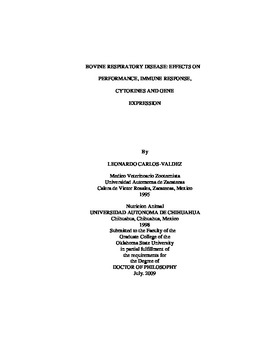| dc.contributor.advisor | Krehbiel, Clint R. | |
| dc.contributor.author | Carlos-Valdez, Leonardo | |
| dc.date.accessioned | 2013-11-26T08:22:32Z | |
| dc.date.available | 2013-11-26T08:22:32Z | |
| dc.date.issued | 2009-07 | |
| dc.identifier.uri | https://hdl.handle.net/11244/6591 | |
| dc.description.abstract | Scope and Method of Study: The objective was to determine the effects of timing of an intratracheal Mannheimia haemolytica challenge relative to 72-hour exposure to bovine viral diarrhea type 1b (BVDV1b) persistently infected calves (PI) on serum antibody production, total and differential white blood cell count (WBC), clinical signs, and performance of feedlot steers. Twenty-four steers (initial BW = 276 � 31 kg) were randomly allocated to one of three treatments (eight animals/treatment) in a randomized complete block design. Treatments were: 1) steers not challenged with BVDV or M. haemolytica (CON); 2) steers intratracheally challenged with M. haemolytica 84 hours after being exposed to calves PI with BVDV1b for 72 hours (LateCh); and 3) steers intratracheally challenged with M. haemolytica 12 hours after being exposed to calves PI with BVDV1b for 72 hours (EarlyCh). In the second experiment we used 18 steers of the original 24. Our objective was to determine the effects of two different timings of an intratracheal M. haemolytica (MH) serotype 1 challenge following short-term exposure (72 hours) to BVDV type 1b on serum concentrations of cytokines and gene expression of cytokines in subcutaneous fat (SCF) and longissimus dorsi muscle (LM) in growing beef steers. | |
| dc.description.abstract | Findings and Conclusions: Delaying the M. haemolytica challenge for 84 hours after exposure to calves PI with BVDV increased clinical attitude of BRD and the acute phase response compared with delaying M. haemolytica challenge for 12 hours after BVDV exposure. The increased clinical and acute phase response did not affect short-term performance, which appeared to be driven by the greater decrease in dry matter intake for EarlyCh steers. For the second experiment we concluded that the differences in gene expression profiles in LM and SCF and an increment in serum cytokine concentrations during induction of the acute phase protein response to pathogens commonly associated with BRD could ultimately decrease animal growth and carcass quality in growing beef steers. | |
| dc.format | application/pdf | |
| dc.language | en_US | |
| dc.rights | Copyright is held by the author who has granted the Oklahoma State University Library the non-exclusive right to share this material in its institutional repository. Contact Digital Library Services at lib-dls@okstate.edu or 405-744-9161 for the permission policy on the use, reproduction or distribution of this material. | |
| dc.title | Bovine respiratory disease: Effects on performance, immune response, cytokines and gene expression | |
| dc.contributor.committeeMember | Horn, Gerald W. | |
| dc.contributor.committeeMember | DeSilva, Udaya | |
| dc.contributor.committeeMember | Step, Douglas L. | |
| osu.filename | CarlosValdez_okstate_0664D_10436.pdf | |
| osu.accesstype | Open Access | |
| dc.type.genre | Dissertation | |
| dc.type.material | Text | |
| dc.subject.keywords | bovine respiratory disease | |
| dc.subject.keywords | immune response | |
| dc.subject.keywords | gene expression | |
| thesis.degree.discipline | Animal Nutrition | |
| thesis.degree.grantor | Oklahoma State University | |
